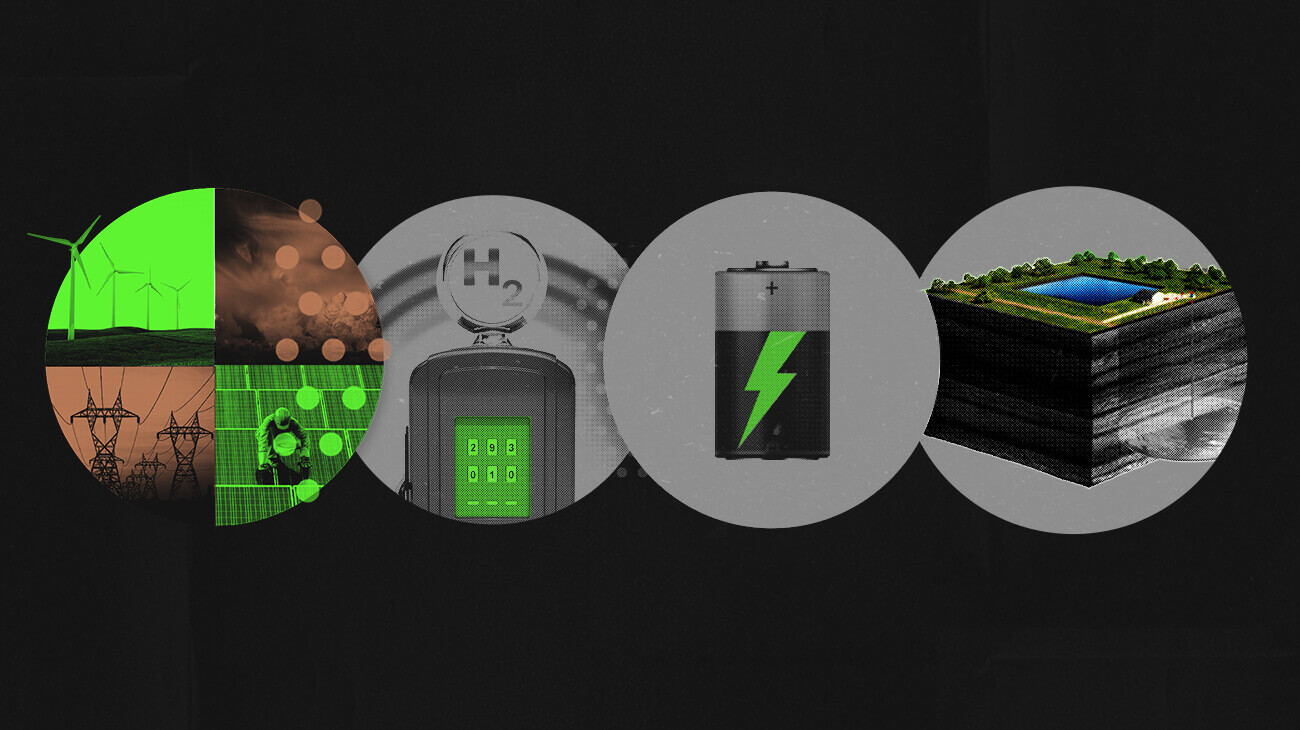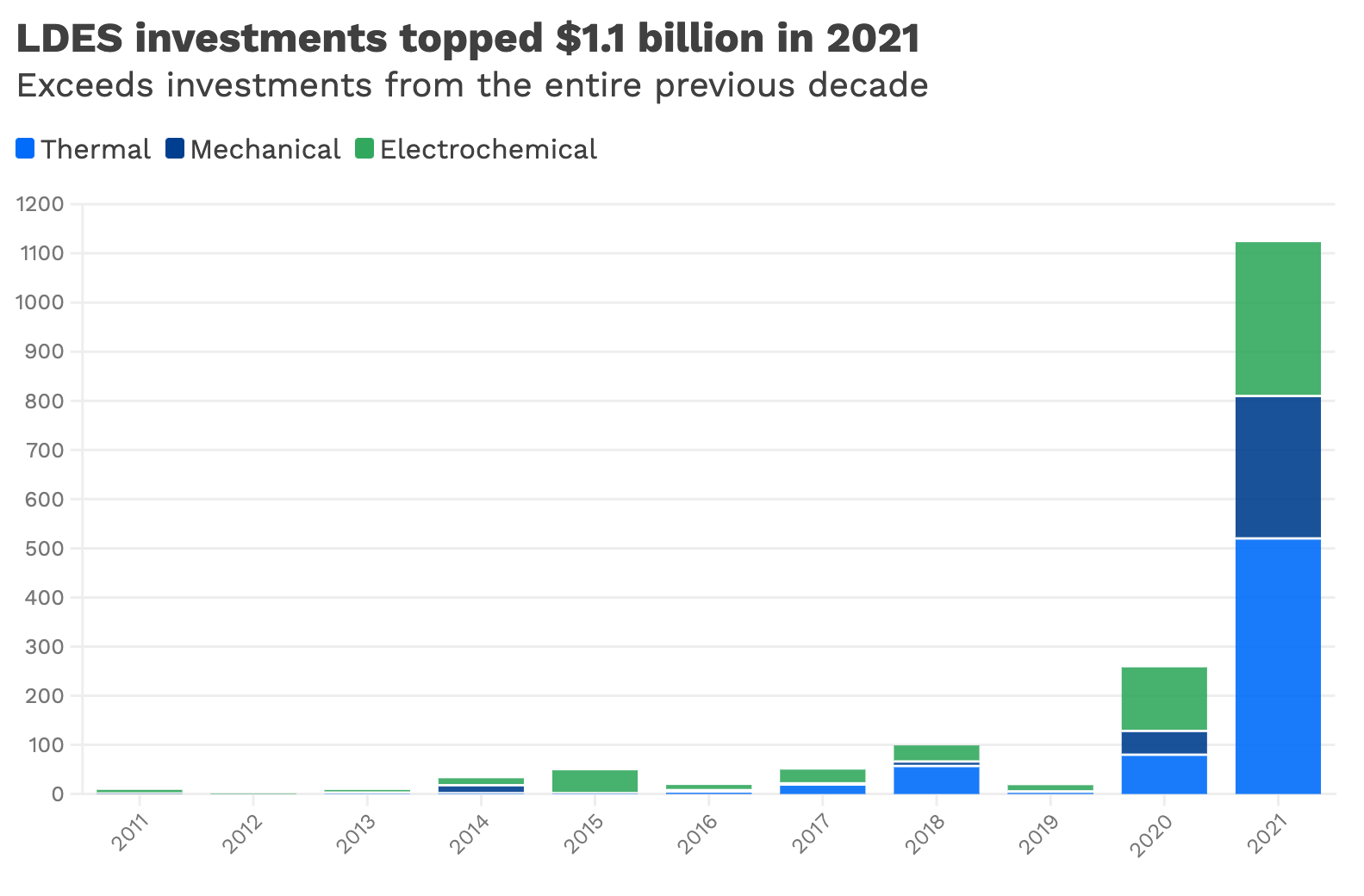Renewables are cheap but not always available: storage solutions
Explainers
A race for commercial solutions is underway to store renewable energy for long periods of time, but financing remains one of the main stumbling blocks to deployment.
There is no agreed definition for when LDES starts, but it generally includes technologies that can store renewable energy from six-to-10 hours upwards, said Patrick Clerens, secretary general of the European Association for Storage of Energy (EASE), a Brussels-based advocacy group.
Several technologies are currently at different development stages aiming to fill the renewables’ variability gap, either as solutions that plug into an entire grid or others that target a specific industrial activity. These range in their ability to store energy from multiple hours to several days and weeks. Experts agree that seasonal storage—of several months—is still aspirational.
LDES technologies fall into four main categories: thermal, electrochemical, mechanical and chemical. Let’s look at each, realizing we are skimming the surface of complex science.
Thermal LDES uses heat to store energy.
One example is Malta Inc., based in Cambridge, Mass., which takes electricity from the grid, converts it into thermal energy and stores it in the form of molten salt (which becomes liquid at high temperatures) for about 10 to 20 hours. When power is needed back on the grid, the energy is reconverted into electricity.
Malta is looking to develop seven projects in sunny Spain, which wants to get three-quarters of its electricity from renewables by 2030. One of the projects is in the permitting process, said Malta CEO Ramya Swaminathan.
Another example is Swedish company SaltX Technology Holding, which has two pilot projects in Stockholm and Berlin. The system stores excess renewable electricity in nanocoated salt. This allows the salt to remain in crystal form, which stops it from clumping and creates storage capability.
The system makes it possible to discharge renewable electricity into both cities’ district heating sectors as needed. District heating sectors are unique and represent 10% of the EU’s heating market, but SaltX’s storage systems can also release steam, which can be used in industrial processes.
Rondo Energy, based in Oakland, Calif., stores the power in thousands of tons of bricks that are heated by temperatures of up to 1,500 degrees Celsius. The heat is delivered for various industrial processes.
(Cipher did an earlier Explained article on heat of all types.)
Electrochemical LDES refers to batteries of different chemistries that store energy.
One example is flow batteries, which have a much longer life cycle than the more commonly known lithium-ion batteries that work only for short-term storage (like those needed in electric cars).
China connected the world’s largest flow battery to the grid at the end of September, while Austrian flow battery manufacturer CellCube earlier this year signed a deal to deploy its technology in southern Africa.
Other batteries, like iron air (which charge and recharge by converting iron into rust and vice versa), are also in the research and pilot phase. One such company, Somerville, Mass.-based Form Energy, just raised $450 million from investors, The Wall Street Journal reported Tuesday.
Mechanical LDES takes advantage of gravitational forces or kinetic energy to store energy.
One example is Houston-based Quidnet Energy, which uses a modern twist to conventional pumped hydro storage (which we outlined last week). Known as geomechanical pumped storage technology, this method pumps water into an underground reservoir to be stored between rock layers at high pressure. When electricity is needed, the water is released upwards, and a hydroelectric turbine generates power.
Earlier this year the company signed a 15-year deal with a Texas utility for its storage services.
Another example of mechanical storage is from U.K.-based Highview Power, whose system stores renewable power in liquid air that was compressed and chilled. The air gets fired up in a turbine when electricity is needed back on the grid. The company, which has been developing its technology with British government support, is planning to build its first grid-scale storage system in Manchester by the end of 2024.
Chemical LDES systems store electricity by creating chemical bonds.
One example is hydrogen storage. This happens through a process called electrolysis, which we’ve written about. Southern California Gas Company is set to launch a pilot project to test its potential.
Julia Souder, executive director of the Long Duration Energy Storage Council, a U.S.-based advocacy group, compares all these LDES technologies to a beehive.
“There are all these different types of bees, but they all serve a purpose: like the honeybees, the yellow jackets, the bumblebees,” she said.
But unlike bees, these technologies are also competing for a share of the growing market—especially when it comes to financing.
Experts say it’s too early to say which type of LDES could become the most popular (or even if such a dominance will occur), but some might be better suited to help decarbonize the power system while others help to decarbonize heating and cooling systems.
Hydrogen as storage could also play a role in the next decades, but significant energy is lost converting electricity into hydrogen and back into electricity.
More than 5 gigawatts of LDES are already operational or announced, according to the LDES Council. That would have to be scaled up to 400 times current levels by 2040 to build a cost-optimal, net-zero energy system, the group said.

Source: BloomberNEF • The chart outlines venture capital and private equity investments of 40 LDES startups. Mechanical includes gravity-based and compressed air technologies; electrochemical includes flow batteries. Data does not include investments in lithium-ion battery technologies, hydrogen storage or traditional pumped hydro.
“The question is not technical viability but financial viability,” Clerens said.
Indeed, high costs are the main issue in deploying LDES technologies at scale.
“We haven’t found a way of cheaply storing huge amounts of energy that we don’t use often,” said Simon Skillings, senior associate at the environmental think tank E3G.
In the United States, the recently passed Inflation Reduction Act, which provides billions of dollars in tax credits to clean energy technologies, “was the rocket ship that launched us right where we needed to go,” Souder said.
In Europe, LDES is getting more traction amid a fast-unravelling energy crisis, putting energy security in the foreground. EASE is calling on the EU to come up with storage-specific targets.
Editor’s note: Investors in Malta Inc., Quidnet Energy, Form Energy and Rondo Energy include Breakthrough Energy Ventures, a venture capital fund within the Breakthrough Energy network, which also supports Cipher. Breakthrough Energy also has a partnership with the European Association for Storage of Energy and is a member of the Long Duration Energy Storage Council.